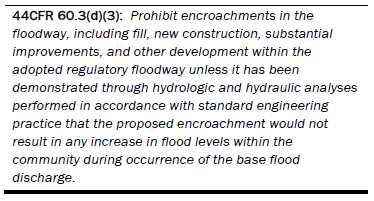

Do you have a building or community official requesting a no-rise for your boathouse (or garage, shed, or other building)? Keep reading for more information about what is involved in a no-rise analysis/certification, and how to go about getting one.
Any development in a FEMA-designated floodway (not a floodplain) requires a no-rise certificate. There are some limited exceptions, which grow smaller and smaller each year. Or officials are more worried about FEMA audits and are asking more than in the past. Either way, whether you are building a sky-scraper or putting in a shed (there may be some exceptions to the shed, but it will be community dependent), you are going to have to hire a professional engineer to perform hydraulic calculations that evaluate if your development will create a rise in flooding levels (base flood elevation, aka 100yr event). Red Mountain Engineering (RME) frequently performs these for our clients.

At its core, a floodway is the area reserved along the stream that will limit any rises in flooding to 1-foot. The federal requirement for building in the floodplain is to require your structure to be elevated at least 1-foot above the base flood elevation (BFE).
Hence, you can see the issue with any development in the floodway that might increase the flooding levels more than 1-foot. And yes, FEMA interprets 0.01-foot a rise that will not meet the standards for a no-rise certificate.
The best approach is to not develop in the floodway!
If you need to, limit the development as much as practical from a simple flow blockage perspective. AND HIRE A SPECIALIST (like Red Mtn Eng!). Ensure you ask if they have performed a no-rise certification before, and remember that the community keeps those on record.
Red Mountain Engineering (RME) and our staff have performed no-rises across Alabama (and in other states as well). That said, RME will never guarantee that you will achieve a no-rise condition (and you should be weary if someone does). RME will be upfront about the likelihood of success and only proceed if there is a good chance. RME also understands there are modeling errors and tolerances that should be considered. Check out this map with some of the project type and location of our past projects in Alabama that were no-rises.

The overall process that your engineer will follow is outlined below. Due to the complex nature and modeling hours required, these projects typically cost several thousands of dollars and can even exceed tens of thousands. One of the most significant factors when it comes to $$ will be the condition of the effective HEC-RAS model. Again, be sure you want to place your development in a floodway because it will cost you.
Get a contract in place
Obtain the effective hydraulic model from FEMA. Note, this can take several months, and there may be no model available.
Update the model to reflect existing conditions.
A model rarely has cross-section data right at the project site. Typically, a new cross-section will have to be placed in the model. This requires topography, Manning's roughness estimation, the dimensions of the development, channel elevation data, possibly structure data, and several other hydraulic inputs.
This could also consider if the hydrology of the site is applicable
Input the proposed development.
Boathouse, pier, barn, shed, building, parking lot (grading), etc.
Evaluate results and impacts
The base flood elevation, floodway elevation, and floodway widths CAN NOT INCREASE.
There are always design iterations that can be explored if the results are not favorable. Our firm, RME, has resorted to this and provided unique solutions that could be integrated into the project, resulting in a no-rise condition.
Generate any reporting required by the local community. This can vary significantly as some communities require complete engineering reports that can add thousands of dollars. To be clear this is well within their rights. A basic report spelling out engineering calculations typically goes along with the no-rise, but some communities require above and beyond that requirement.
Draft and certify the no-rise certification.
The community will review and approve. The community then keeps the no-rise on file, along with the hydraulic calculations in the event that FEMA audits them.

And there you have it. This process can range from a couple of weeks to several months. FEMA discusses in more detail in their floodway guidance document, located here (dated Nov 2021)
Call (205-730-6040) or email RME to get a quote on your no-rise certification.










